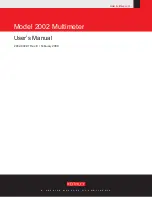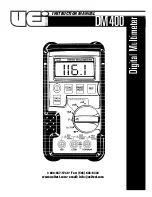
6
Rules For Safe Operation
Warning
To avoid possible electric shock or personal injury,
and to avoid possible damage to the Meter or to the
equipment under test, adhere to the following rules:
Before using the Meter inspect the case. Do not use
the Meter if it is damaged or the case (or part of the
case) is removed. Look for cracks or missing plastic.
Pay attention to the insulation around the connectors.
Inspect the test leads for damaged insulation or exposed
metal. Check the test leads for continuity. Replace
damaged test leads with identical model number or
electrical specifications before using the Meter.
Do not apply more than the rated voltage, as marked
on the Meter, between the terminals or between any
terminal and ground.
Prior to measurement, ensure the rotary selector
switch is in the proper position. To prevent potential
damage to the meter, do not change range or mode
during measurement.
When the Meter working at an effective voltage over
60V DC, or 30V RMS AC, special care should be
taken for there is danger of electric shock.
Use the proper terminals, function, and range for your
measurements.
If the value to be measured is unknown, use the
maximum measurement position and reduce the range
step by step until a satisfactory reading is obtained.
Do not use or store the Meter in an environment of
high temperature, humidity, explosive, flammable gas
or strong magnetic field. Do not use the meter if
allowed to get wet. Even after complete drying,
incorrect readings could occur, causing a potentially
hazardous condition.
When using the test leads, keep your fingers behind
the finger guards.
Disconnect circuit power and discharge all high-voltage
capacitors before testing resistance, continuity, diodes,
current, or capacitance.
Before measuring current, check the Meter’s fuses
and turn off power to the circuit before connecting the
Meter to the circuit.
l
l
l
l
l
l
l
l
l
l
l
Model 72-1016: OPERATING MANUAL
This Manual: http://www.manuallib.com/file/2587080










































